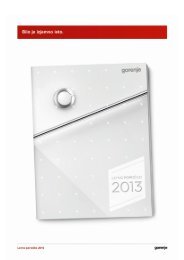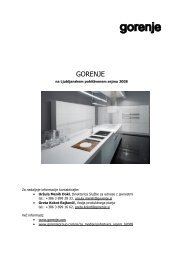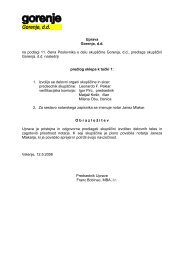ANNUAL REPORT 2008 - Gorenje Group
ANNUAL REPORT 2008 - Gorenje Group
ANNUAL REPORT 2008 - Gorenje Group
You also want an ePaper? Increase the reach of your titles
YUMPU automatically turns print PDFs into web optimized ePapers that Google loves.
85<br />
3. Significant accounting policies<br />
The accounting policies set out below have been applied consistently to all periods presented in<br />
these consolidated financial statements, and have been applied consistently by <strong>Group</strong> entities.<br />
(a) Basis of consolidation<br />
(i) Subsidiaries<br />
Subsidiaries are entities controlled by the <strong>Group</strong>. Control exists when the <strong>Group</strong> has the power to<br />
govern the financial and operating policies of an entity so as to obtain benefits from its activities. In<br />
assessing control, potential voting rights that presently are exercisable are taken into account. The<br />
financial statements of subsidiaries are included in the consolidated financial statements from the<br />
date that control commences until the date that control ceases. The accounting policies of subsidiaries<br />
have been changed when necessary to align them with the policies adopted by the <strong>Group</strong>.<br />
(ii) Acquisitions from entities under common control<br />
Business combinations arising from transfers of interests in entities that are under the control of<br />
the shareholder that controls the <strong>Group</strong> are accounted for as if the acquisition had occurred at the<br />
beginning of the earliest comparative period presented or, if later, at the date that common control<br />
was established; for this purpose comparatives are restated. The assets and liabilities acquired<br />
are recognised at the carrying amounts recognised previously in the <strong>Group</strong>’s controlling shareholder’s<br />
consolidated financial statements. The components of equity of the acquired entities are added<br />
to the same components within <strong>Group</strong> equity except that any share capital of the acquired entities<br />
is recognised as part of share premium. Any cash paid for the acquisition is recognised directly<br />
in equity.<br />
(iii) Jointly controlled operations<br />
A jointly controlled operation is a joint venture carried on by each venturer using its own assets in<br />
pursuit of the joint operations. The consolidated financial statements include the assets that the<br />
<strong>Group</strong> controls and the liabilities that it incurs in the course of pursuing the joint operation, and the<br />
expenses that the <strong>Group</strong> incurs and its share of the income that it earns from the joint operation.<br />
(iv) Transactions eliminated on consolidation<br />
Intra-group balances and transactions, and any unrealised income and expenses arising from intra-group<br />
transactions, are eliminated in preparing the consolidated financial statements. Unrealised<br />
gains arising from transactions with equity accounted investees are eliminated against the investment<br />
to the extent of the <strong>Group</strong>’s interest in the investee. Unrealised losses are eliminated in the<br />
same way as unrealised gains, but only to the extent that there is no evidence of impairment.<br />
(b) Foreign currency<br />
(i) Foreign currency transactions<br />
Transactions in foreign currencies are translated to the respective functional currencies of <strong>Group</strong> entities<br />
at exchange rates at the dates of the transactions. Monetary assets and liabilities denominated<br />
in foreign currencies at the reporting date are retranslated to the functional currency at the exchange<br />
rate at that date. The foreign currency gain or loss on monetary items is the difference between<br />
amortised cost in the functional currency at the beginning of the period, adjusted for effective<br />
interest and payments during the period, and the amortised cost in foreign currency translated<br />
at the exchange rate at the end of the period. Non-monetary assets and liabilities denominated in<br />
foreign currencies that are measured at fair value are retranslated to the functional currency at the<br />
exchange rate at the date that the fair value was determined. Foreign currency differences arising<br />
on retranslation are recognised in profit or loss, except for differences arising on the retranslation of<br />
available-for-sale equity instruments, a financial liability designated as a hedge of the net investment<br />
in a foreign operation, or qualifying cash flow hedges, which are recognised directly in equity.

















